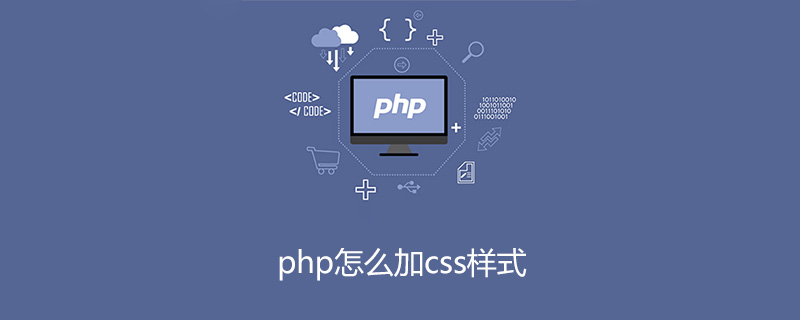How to add css style in php

Using php, you can output HTML tags, which brings great convenience to page design.
Record here the problem of setting CSS style for php output tags:
echo can use '', "" or you don't need quotes, If you want to output HTML tags with CSS style , just use 'echo' to output.
About the differences between the three echo outputs:
1. Integer values can be output directly. Numbers and the like can be output directly without quotation marks.
2. The output variable can also be output without any quotation marks. Just echo $a;. To output characters, you must add quotation marks. For example, echo "Hello world!";
3. Regarding single quotes and double quotes, there is only one difference. Variables and operators in single quotes will not be interpreted. Output as is. The content in double quotes will be interpreted as the corresponding content.
For example
$a=1;
echo "$a"; //Output 1 variable is interpreted.
echo '$a'; //The output $a variable is not interpreted.
If you want to output characters and variables together, use double quotes. If you are just outputting plain text content, you can use single quotes.
For example:
echo "$a";
echo 'Hello world!';
PHP scripts can also introduce css styles. The code examples are as follows:
css statements:
<style type="text/css">
table {
margin: 8px;
}
th {
font-family: Arial, Helvetica, sans-serif;
font-size:. 7em;
background: #666;
color: #FFF;
padding: 2px 6px;
border-collapse: separate;
border: 1px solid #000;
}
td {
font-family: Arial, Helvetica, sans-serif;
font-size:. 7em;
border: 1px solid #DDD;
}
</style>PHP statements refer to css styles:
<?php>
echo"<table>";
echo"<tr><th>ID</th><th>hashtag</th></tr>";
while($row = mysql_fetch_row($result))
{
echo"<tr onmouseover="hilite(this)" onmouseout="lowlite(this)"><td>$row[0]</td> <td>$row[1]</td></tr>n";
}
echo"</table>";
<?>Recommended: "PHP Graphic Tutorial"
The above is the detailed content of How to add css style in php. For more information, please follow other related articles on the PHP Chinese website!

Hot AI Tools

Undresser.AI Undress
AI-powered app for creating realistic nude photos

AI Clothes Remover
Online AI tool for removing clothes from photos.

Undress AI Tool
Undress images for free

Clothoff.io
AI clothes remover

Video Face Swap
Swap faces in any video effortlessly with our completely free AI face swap tool!

Hot Article

Hot Tools

Notepad++7.3.1
Easy-to-use and free code editor

SublimeText3 Chinese version
Chinese version, very easy to use

Zend Studio 13.0.1
Powerful PHP integrated development environment

Dreamweaver CS6
Visual web development tools

SublimeText3 Mac version
God-level code editing software (SublimeText3)

Hot Topics
 1389
1389
 52
52
 OWASP Top 10 PHP: Describe and mitigate common vulnerabilities.
Mar 26, 2025 pm 04:13 PM
OWASP Top 10 PHP: Describe and mitigate common vulnerabilities.
Mar 26, 2025 pm 04:13 PM
The article discusses OWASP Top 10 vulnerabilities in PHP and mitigation strategies. Key issues include injection, broken authentication, and XSS, with recommended tools for monitoring and securing PHP applications.
 PHP 8 JIT (Just-In-Time) Compilation: How it improves performance.
Mar 25, 2025 am 10:37 AM
PHP 8 JIT (Just-In-Time) Compilation: How it improves performance.
Mar 25, 2025 am 10:37 AM
PHP 8's JIT compilation enhances performance by compiling frequently executed code into machine code, benefiting applications with heavy computations and reducing execution times.
 PHP Secure File Uploads: Preventing file-related vulnerabilities.
Mar 26, 2025 pm 04:18 PM
PHP Secure File Uploads: Preventing file-related vulnerabilities.
Mar 26, 2025 pm 04:18 PM
The article discusses securing PHP file uploads to prevent vulnerabilities like code injection. It focuses on file type validation, secure storage, and error handling to enhance application security.
 PHP Encryption: Symmetric vs. asymmetric encryption.
Mar 25, 2025 pm 03:12 PM
PHP Encryption: Symmetric vs. asymmetric encryption.
Mar 25, 2025 pm 03:12 PM
The article discusses symmetric and asymmetric encryption in PHP, comparing their suitability, performance, and security differences. Symmetric encryption is faster and suited for bulk data, while asymmetric is used for secure key exchange.
 PHP Authentication & Authorization: Secure implementation.
Mar 25, 2025 pm 03:06 PM
PHP Authentication & Authorization: Secure implementation.
Mar 25, 2025 pm 03:06 PM
The article discusses implementing robust authentication and authorization in PHP to prevent unauthorized access, detailing best practices and recommending security-enhancing tools.
 PHP API Rate Limiting: Implementation strategies.
Mar 26, 2025 pm 04:16 PM
PHP API Rate Limiting: Implementation strategies.
Mar 26, 2025 pm 04:16 PM
The article discusses strategies for implementing API rate limiting in PHP, including algorithms like Token Bucket and Leaky Bucket, and using libraries like symfony/rate-limiter. It also covers monitoring, dynamically adjusting rate limits, and hand
 PHP Input Validation: Best practices.
Mar 26, 2025 pm 04:17 PM
PHP Input Validation: Best practices.
Mar 26, 2025 pm 04:17 PM
Article discusses best practices for PHP input validation to enhance security, focusing on techniques like using built-in functions, whitelist approach, and server-side validation.
 PHP CSRF Protection: How to prevent CSRF attacks.
Mar 25, 2025 pm 03:05 PM
PHP CSRF Protection: How to prevent CSRF attacks.
Mar 25, 2025 pm 03:05 PM
The article discusses strategies to prevent CSRF attacks in PHP, including using CSRF tokens, Same-Site cookies, and proper session management.




